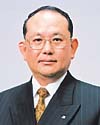
Celebration of a New Beginning for STRL
 2002
will see the start of activities in the Science & Technical Research
Laboratories' new research complex. At the beginning of the new year,
we interviewed Executive Director-General of Engineering Mr. Hiroshi Nakamura
and asked about his aspirations for the coming year and his expectations
for the Science & Technical Research Laboratories (STRL). 2002
will see the start of activities in the Science & Technical Research
Laboratories' new research complex. At the beginning of the new year,
we interviewed Executive Director-General of Engineering Mr. Hiroshi Nakamura
and asked about his aspirations for the coming year and his expectations
for the Science & Technical Research Laboratories (STRL).
Q: What would you say about 2001, looking back
at the year?
The 21st century started as 'the century of true peace and dialogue'
and the 'beginning of the IT era through digital technology.' However,
unfortunately, the simultaneous terrorist attacks in the United States
and the subsequent war in Afghanistan plunged the world into an opaque
situation both politically and economically, seriously affecting the
IT industry. On the other hand, viewers showed keen interest in this
series of reports, in which NHK's news coverage was both prompt and
fair.
On the domestic scene, the NHK Science & Technical Research Laboratories
has developed an 'Mid-to Long-term Vision' for research projects and
operations 10 to 15 years into the future. The new STRL buildings were
completed at the end of October. There was also progress on digital
BS broadcasting diffusion and preparations for digital terrestrial broadcasting.
Therefore, it can be said that steady steps were taken for the future
even in a climate of upheaval.
Q: What is your opinion on the role of STRL
in the 21st century?
STRL will open its new complex as a facility to produce new technologies,
and to train new personnel, in support of 21st century broadcasting.
Broadcasting is a culture that utilizes the latest technologies. STRL
has developed and implemented new broadcasting systems, such as satellite
broadcasting, Hi-Vision (HDTV), and ISDB, and new devices, including
PDPs and ultrahigh-sensitivity HARP cameras. These technological developments
multiplied by an inventiveness in contents production, have significantly
advanced broadcasting.
In the future, I believe that STRL needs to play an important role in
research and development of digital contents and core technologies.
Centering on the three main research themes, of 'advanced ISDB,' 'contents
production technology,' and 'future broadcasting services and core technologies,'
I particularly foresee development of a 4,000 scanning line ultra high-definition
TV system, a flexible display, and 3D TV without the need of special
glasses. I believe that it is crucial to promote studies on digital
technology, to realize a society in which all viewers, including the
elderly and those who have visual or hearing impairments, can share
the same information.
Q: Finally, could you share your aspirations
for 2002?
After we move into the new building, the work of STRL will accelerate
in the new building. At the opening ceremony on March 6, we will publicly
present our 'Mid- to Long-term Vision' not only to Japan but also to
the world. With this new vision, I believe NHK will walk confidently
into the 21st century, toward the maturity of digital broadcasting,
further pioneering new broadcasting services in support of the next
generation.
|
 |
 |
| CONTENTS |
Top News

|
 |
 |
Celebration
of a New Beginning for STRL |
 |
 |
The
Start of Research at the New STRL Research Complex |
Topics

|
 |
 |
First
anniversary of BS digital broadcasting |
 |
 |
Simultaneous
Subtitling of Live Broadcast Programs by Automatic Recognition of
Re-spoken Speech |
 |
 |
NHK
Learning Fair 2001 |
 |
 |
Clinical
Trial of Retinal Surgical System Using Super-HARP HDTV Camera |
 |
 |
Digital
Terrestrial Broadcasting Experiment for Mobile Reception on Shinkansen
Super-Express Railways |
Lecture

|
 |
 |
Technologies
and Services on Digital Broadcasting (1):
Significance of Digital Broadcasting |
 |
 |
Technologies
and Services on Digital Broadcasting (2):
Source Coding
-High-efficiency coding of video signals- |
Features

|
 |
 |
Understanding
Knowledge and Information |
About us

|
 |
 |
Overview
of Laboratories |
 |
 |
 
 
 

|
|

 2002
will see the start of activities in the Science & Technical Research
Laboratories' new research complex. At the beginning of the new year,
we interviewed Executive Director-General of Engineering Mr. Hiroshi Nakamura
and asked about his aspirations for the coming year and his expectations
for the Science & Technical Research Laboratories (STRL).
2002
will see the start of activities in the Science & Technical Research
Laboratories' new research complex. At the beginning of the new year,
we interviewed Executive Director-General of Engineering Mr. Hiroshi Nakamura
and asked about his aspirations for the coming year and his expectations
for the Science & Technical Research Laboratories (STRL).